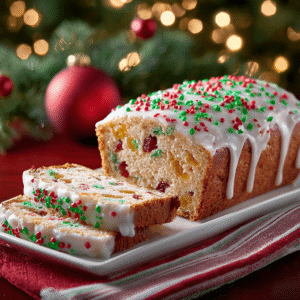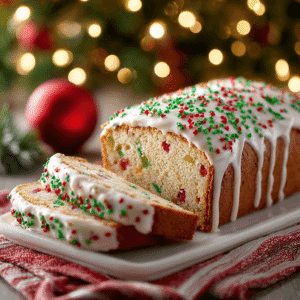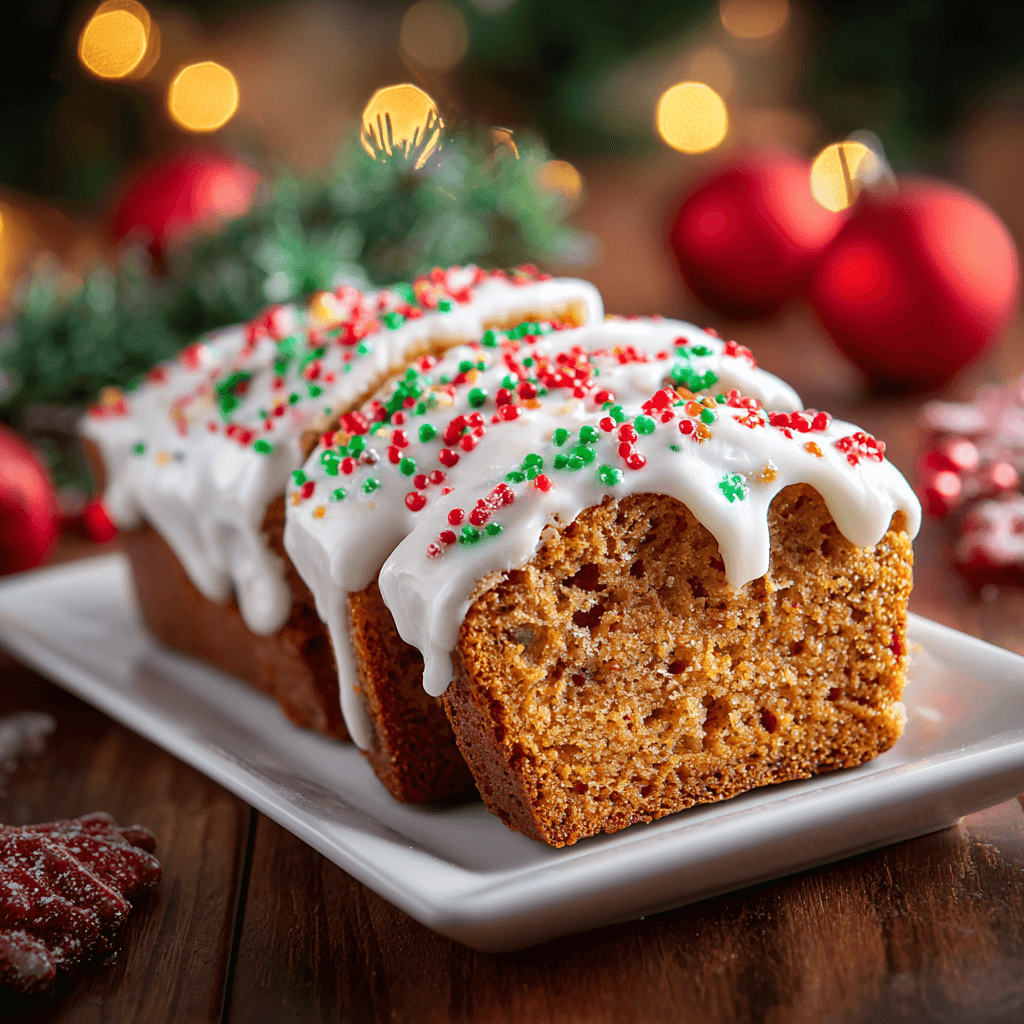There’s a magical moment every Christmas morning in my house—the moment when the kitchen fills with the aroma of freshly baked Christmas bread. It started five years ago when I decided to create a new holiday tradition, something that would make our Christmas breakfast special. I wanted more than just cinnamon rolls or regular toast. I wanted something that looked festive, tasted incredible, and felt like Christmas itself.
That’s when I discovered the joy of making festive Christmas bread studded with colorful candied fruits and topped with sweet glaze and sprinkles. The first time I pulled that golden loaf from the oven, with its jewel-toned fruit pieces peeking through the tender crumb and that gorgeous white glaze cascading down the sides, I knew I’d found something special. Now, five years later, Christmas morning doesn’t feel complete without it.
This festive Christmas bread is more than just delicious—it’s beautiful. The vibrant red and green candied cherries scattered throughout the golden bread create a festive appearance that screams holiday cheer. When you slice into it, revealing the colorful fruit distribution and the tender, slightly sweet crumb, it’s like unwrapping a present. The white glaze with festive sprinkles on top adds that final decorative touch that makes it unmistakably Christmas.
Why This Christmas Bread Deserves a Place on Your Holiday Table
The Perfect Balance of Sweet and Bread
What makes this festive Christmas bread so special is how it occupies that perfect middle ground between dessert and breakfast bread. It’s sweet enough to feel indulgent and celebratory but not so sweet that it overwhelms your palate first thing in the morning. The base is a tender, enriched bread—slightly sweeter than sandwich bread but more substantial than cake.
The candied fruits add pops of intense sweetness without making the entire loaf sugary. This balance means you can enjoy a thick slice with your morning coffee without feeling like you’ve just eaten dessert for breakfast. It’s appropriate for any time of day, from Christmas morning breakfast to afternoon tea to evening dessert.
Visual Impact That Wows
Let’s be honest—presentation matters during the holidays. When you place this Christmas bread on the table, with its festive colors, glossy glaze, and cheerful sprinkles, it becomes an instant centerpiece. The red and green candied fruits create a traditional holiday color scheme that feels nostalgic and comforting.
When you slice the bread, each piece reveals a beautiful interior studded with colorful fruit pieces. It looks professional and impressive, yet it’s achievable for home bakers. Your guests will think you spent hours on this festive Christmas bread when the actual hands-on time is quite reasonable.
Aromatic Holiday Magic
Beyond taste and appearance, this Christmas bread fills your home with an intoxicating aroma that enhances the holiday atmosphere. As it bakes, the scent of butter, vanilla, and candied fruit mingles together, creating a perfume that signals comfort and celebration. It’s the kind of smell that makes everyone gravitate toward the kitchen, asking when they can have a slice.
This aromatic quality makes the bread perfect for Christmas morning when you want the house to smell welcoming and festive as family members wake up and gather. It creates an olfactory memory that becomes intertwined with holiday traditions.
Essential Ingredients for Festive Christmas Bread
Bread Base Components
- 4 cups all-purpose flour, plus extra for kneading
- 1/2 cup granulated sugar
- 2 1/4 teaspoons active dry yeast (one packet)
- 1 teaspoon salt
- 1 cup whole milk, warmed to 110°F
- 1/3 cup unsalted butter, melted
- 2 large eggs
- 2 teaspoons vanilla extract
- 1 teaspoon almond extract (optional but recommended)
Festive Additions
- 1 cup candied cherries (red and green), halved
- 1/2 cup chopped candied pineapple or citrus peel
- 1/2 cup golden raisins (optional)
- 1 tablespoon flour (for coating the fruit)
Glaze and Decoration
- 1 1/2 cups powdered sugar
- 2-3 tablespoons milk
- 1/2 teaspoon vanilla extract
- Red and green sprinkles or nonpareils
- Extra candied cherries for decoration (optional)

Complete Baking Instructions
Preparing the Yeast and Dough Base
Begin by warming your milk to 110°F—this temperature is crucial for activating the yeast without killing it. Pour the warm milk into a small bowl and sprinkle the yeast over the top. Add a pinch of sugar and let it sit for 5-10 minutes until foamy. This “blooming” process proves your yeast is active and ready to leaven your festive Christmas bread.
In a large mixing bowl, combine 3 1/2 cups of flour, sugar, and salt. Create a well in the center and add the yeast mixture, melted butter, eggs, vanilla extract, and almond extract. Using a wooden spoon or your hands, mix until a shaggy dough forms. The mixture will seem messy at this stage—that’s normal.
Kneading and First Rise
Turn the dough out onto a floured surface and knead for 8-10 minutes, adding the remaining flour gradually as needed. You’re looking for a smooth, elastic dough that’s slightly tacky but not sticky. Proper kneading develops the gluten structure that gives your Christmas bread its tender yet structured crumb.
This kneading process is therapeutic—there’s something meditative about the rhythmic push and fold. You’ll feel the dough transform under your hands, becoming smoother and more cohesive. When you can stretch a small piece of dough thin enough to see light through it without it tearing (the “windowpane test”), you’ve kneaded enough.
Place the dough in a greased bowl, turning once to coat all sides. Cover with a damp kitchen towel or plastic wrap and let it rise in a warm, draft-free place for 1-1.5 hours, or until doubled in size. During winter, I like to place my bowl near (not on) a radiator or in an oven with just the light on.
Incorporating the Festive Fruits
While your dough rises, prepare your candied fruits. Toss the halved candied cherries, chopped candied pineapple, and raisins (if using) with 1 tablespoon of flour. This coating prevents the fruits from sinking to the bottom of your Christmas bread during baking—a common problem that this simple trick solves completely.
Once your dough has doubled, punch it down to release the gases. Turn it out onto a floured surface and flatten it into a rectangle about 1 inch thick. Scatter the floured fruit evenly over the surface, then fold the dough over itself several times, kneading gently to distribute the fruit throughout. You want relatively even distribution, though some clustering is fine and adds visual interest.
Shaping and Second Rise
Shape your dough into a loaf. For a traditional presentation, form it into a rounded oval or a rectangular loaf shape. Place it in a greased 9×5-inch loaf pan or shape it into a free-form loaf on a parchment-lined baking sheet. I prefer the loaf pan for even slicing, but a free-form loaf has a more rustic, artisan appearance.
Cover the shaped dough and let it rise again for 45-60 minutes, until it’s puffy and has risen noticeably. This second rise is crucial for the light, tender texture that makes this festive Christmas bread so delightful. Don’t rush this step—good bread requires patience.
Baking Your Festive Christmas Bread
Preheat your oven to 350°F (175°C) about 20 minutes before your bread finishes its second rise. When ready to bake, you can brush the top with an egg wash (one beaten egg) for extra shine, though this is optional—the glaze will provide plenty of visual appeal later.
Bake for 35-45 minutes, or until the bread is golden brown and sounds hollow when tapped on the bottom. An instant-read thermometer inserted into the center should read 190-195°F. The candied fruit creates hot pockets in the bread, so internal temperature is more reliable than visual cues alone.
If the top browns too quickly, tent the bread loosely with aluminum foil for the last 10-15 minutes of baking. Remove from the oven and let cool in the pan for 10 minutes, then turn out onto a wire rack to cool completely before glazing.
Creating and Applying the Glaze
Once your Christmas bread is completely cool—this is important, as glaze on warm bread will simply melt and run off—prepare your glaze. In a medium bowl, whisk together the powdered sugar, milk (starting with 2 tablespoons), and vanilla extract. You want a thick but pourable consistency. Add more milk drop by drop if it’s too thick, or more powdered sugar if too thin.
Place your cooled bread on a serving platter or cutting board with parchment paper underneath to catch drips. Pour the glaze over the top, using a spoon or offset spatula to encourage it to cascade down the sides in attractive drips. Immediately sprinkle with red and green sprinkles while the glaze is still wet—they’ll set in place as the glaze dries.
For extra festive appeal, you can arrange a few whole candied cherries on top while the glaze is wet, pressing them gently to adhere. Let the glaze set for at least 20 minutes before slicing.

Nutritional Information
Per Slice (based on 12 slices)
- Calories: 310
- Protein: 6g
- Carbohydrates: 58g
- Fat: 7g
- Saturated Fat: 4g
- Cholesterol: 50mg
- Sodium: 220mg
- Fiber: 1g
- Sugar: 32g
This festive Christmas bread is definitely a treat rather than everyday food. The sugar content is significant, but it’s appropriate for special holiday occasions. Each slice provides some protein and complex carbohydrates alongside the indulgent sweetness.
Variations and Customization Ideas
Flavor Variations for Christmas Bread
While the classic version is wonderful, you can easily customize this festive bread to suit different tastes. For a chocolate variation, add 1/4 cup cocoa powder to the flour mixture and fold in chocolate chips instead of some of the candied fruit. The result is like a panettone-brownie hybrid that chocolate lovers will adore.
For a more sophisticated flavor, increase the almond extract to 1 tablespoon and add 1/2 cup toasted sliced almonds to the dough along with the fruit. Top with almond-flavored glaze (use almond extract instead of vanilla) for an elegant twist on traditional Christmas bread.
You can also make this bread more citrus-forward by adding the zest of one orange and one lemon to the dough. Replace half the candied cherries with candied orange peel. This creates a bright, refreshing version that’s particularly nice with afternoon tea.
Dietary Modifications
For those who need to accommodate dietary restrictions, this Christmas bread recipe is adaptable. To make it dairy-free, substitute the milk with almond, oat, or soy milk, and use vegan butter. The texture remains nearly identical. For the glaze, use non-dairy milk.
If you want to reduce sugar, you can cut the sugar in the dough to 1/3 cup without dramatically affecting texture—the bread will be slightly less tender but still delicious. The glaze is harder to modify since it requires powdered sugar for structure, but you can use less of it or skip it entirely, perhaps just dusting the bread with powdered sugar instead.
Size and Shape Options
This dough is versatile in terms of shaping. Instead of one large loaf, divide the dough into three portions and braid them together for a stunning braided Christmas bread. The braid showcases the colorful fruit beautifully and makes impressive presentation.
You can also make individual rolls—divide the dough into 12 portions, shape into balls, and place in a greased 9×13-inch pan. They’ll bake together into pull-apart rolls perfect for a crowd. Reduce baking time to 25-30 minutes for the rolls.
Serving Suggestions and Pairings
Christmas Morning Presentation
On Christmas morning, slice this festive bread into thick pieces and serve it slightly warm (just a few seconds in the microwave). The warmth brings out the flavors and makes the bread feel extra comforting. Accompany it with butter, cream cheese, or nothing at all—it’s delicious plain.
Set out a beautiful platter with the sliced bread, along with fresh fruit, some yogurt, and perhaps scrambled eggs for a complete Christmas breakfast. The bread provides the centerpiece while the other items offer balance and variety.
Afternoon Tea Service
This Christmas bread also shines as part of an afternoon holiday tea. Slice it thin and serve alongside other sweets like cookies, brownies, and petit fours. The bread’s relatively modest sweetness makes it a nice contrast to richer desserts.
Pair it with hot tea—English Breakfast, Earl Grey, or a festive blend with cinnamon and orange. The tannins in tea cut through the sweetness of the glaze perfectly. Hot chocolate or spiced apple cider are also wonderful non-tea options.
Gift-Giving Presentation
Festive Christmas bread makes an excellent homemade gift. Once completely cool and glazed, wrap it tightly in plastic wrap, then in festive cellophane or tissue paper. Tie with a ribbon and attach a tag with storage instructions. Recipients will be thrilled to receive such a thoughtful, homemade treat.
For gift-giving, I often make mini loaves using smaller loaf pans. Divide the dough into three or four portions, shape into smaller loaves, and reduce baking time to 25-30 minutes. These individual-sized breads are perfect for neighbors, teachers, or coworkers.
Storage and Keeping Quality
Optimal Storage Methods
Once completely cool, store your Christmas bread tightly wrapped in plastic wrap or in an airtight container at room temperature for up to 4 days. The bread actually stays moist quite well due to the butter and sugar content. Don’t refrigerate it—refrigeration accelerates staling in bread.
If you’ve already glazed the bread, be careful how you wrap it to avoid smearing the pretty decoration. I like to use a cake dome or a large container that allows the bread to sit without the wrap touching the top.
Freezing for Long-Term Storage
This festive Christmas bread freezes beautifully, making it perfect for advance baking. Wrap the completely cooled, UN-glazed bread tightly in plastic wrap, then in aluminum foil or a freezer bag. Freeze for up to 3 months. Thaw overnight at room temperature, then glaze before serving.
Alternatively, you can freeze individual slices wrapped in plastic wrap for grab-and-go breakfasts throughout the season. Toast frozen slices directly in the toaster for a quick morning treat.
Reviving Day-Old Bread
If your Christmas bread seems a bit dry after a day or two, don’t despair. Wrap it in foil and warm it in a 300°F oven for 10-15 minutes. This revives the texture, making it taste freshly baked again. You can also toast slices and spread them with butter—delicious!
My Expert Tips for Perfect Christmas Bread
After years of making this festive Christmas bread, I’ve learned several tricks that guarantee success. First, don’t skimp on the kneading time. Under-kneaded dough produces dense, heavy bread. Set a timer for those full 8-10 minutes and trust the process. Your arms might get tired, but the results are worth it.
Second, resist the urge to add too much flour. Dough should be slightly tacky, not completely dry. Too much flour creates tough, dry bread. Add flour gradually during kneading, just enough to prevent excessive sticking.
Third—and this is crucial—make sure your milk is the right temperature. Too hot and you’ll kill the yeast; too cold and the yeast won’t activate properly. Invest in an instant-read thermometer if you don’t have one. Taking your milk to exactly 110°F removes guesswork and virtually guarantees success.
Fourth, patience with rising times makes all the difference. Don’t rush the rises. If your kitchen is cold, the dough might take longer than the suggested times—that’s fine. Wait until the dough has actually doubled, even if it takes an extra 30 minutes. Well-risen dough creates light, fluffy bread.
Finally, my secret ingredient: a touch of almond extract. It’s optional in the recipe, but I never skip it. That subtle almond undertone complements the vanilla and candied fruit beautifully, adding complexity that makes people wonder, “What’s that delicious flavor I can’t quite identify?”
This festive Christmas bread has become more than just a recipe in my house—it’s a symbol of holiday joy, a edible representation of the care and time we put into making Christmas special. Every year when I make it, I’m reminded of why we create traditions: they ground us, connect us to past Christmases, and give us something to look forward to year after year.
